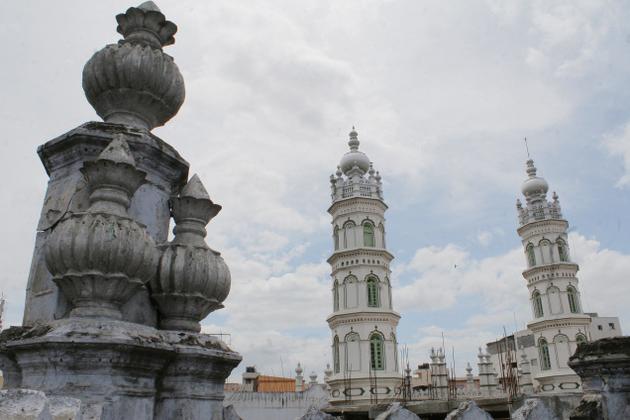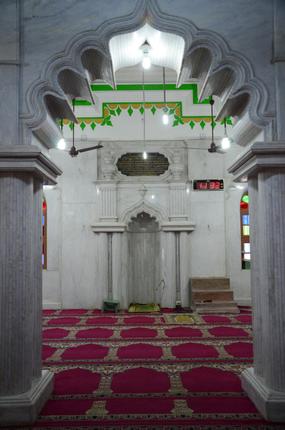Mosques in history

Striking architecture, history and faith greet K. Jeshi as she visits some old monuments
Tipu Sultan offered prayers at Kottaimedu. His soldiers prayed at the Thondamuthur mosque. On their way to battle at Palakkad, they rested at Idayarpalayam with their horses. Then in the 1800s Athar merchants from Tirunelveli made Coimbatore their home and built the Athar Jamath mosque. According to M.I. Mohammed Ali, general secretary of Coimbatore District United Jamath (that heads 193 Jamaths in Coimbatore district), there are 120 mosques within the corporation limits. “In some mosques the older structures have given way to expansion while some Jamaths have taken efforts to preserve them.”

Athar Jamath Mosque
Oppanakkara Street
A pair of silver minarets shimmer in the morning. It’s 9 a.m. and sun rays filter into the Mosque on the bustling Oppanakkara Street, one of the oldest mosques in the city. Traders stroll in one by one, some of them straight from the market with their goods, spend a few minutes in silent prayer and get going. It is not just Muslims, people from other religious communities too stop by.
At the entrance, a giant hand-crafted wrought iron gate gives way to a hauz or a water pool (where Muslims perform a ritual before offering their namaz) and then comes the prayer hall. The building has Italian and Mohammedan architecture influences. The white pillars that dot the prayer hall are Italian while the colour scheme of white and green and the multi-coloured window glasses are quintessentially Mughal. Externally, the domes are decorated with geometric designs. “It was a thatched hut in the 1830s built by our forefathers who were athar sellers from Tirunelveli district,” says Abdul Kaleel, a retired Tahsildar and muttavalli (head imam ) of the mosque. The Jamath has over 1000 members, all descendants of athar merchants. An executive committee with 15 members looks into the maintenance of the mosque. The construction, spread across 10,000 sq.ft., began in 1860 and was completed in 1904, under the supervision of 52 athar families. “Our forefathers had their homes in the area and built the mosque here,” says Kaleel. The mosque is built beside the tomb of Hazrat Jamesha Waliullah, which is now a dargah. “On the same road, we have St. Michael’s Church, Koniamman temple and the mosque. All the structures are over 100 years and they stand testimony to a time when communities beautifully co-existed. Even today, the Koniamman temple car procession halts at the mosque for a few minutes and then proceeds,” he says. Personalities including Russian premier Nikita Sergeyevich Khrushchev, Prime Minister Jawaharlal Nehru, and stalwarts such as Kamarajar and Kalaignar Karunanidhi have visited the mosque. The prayer hall easily accommodates 3000 people during prayers on Eid. “Fifty years ago, we could see the minarets of the mosque when we trekked to the Marudhamalai Hills,” says Kaleel.
Kottai Hidayathul Islam Safia Jamath Mosque
Kottaimedu
Kottai Hidayathul Islam Safia Jamath stands tall at Kottaimedu. It dates back to the 17th Century and is one of the biggest mosques to be built in Coimbatore during the reign of Tipu Sultan. He is supposed to have offered prayers here. “The original mosque was built in 1776 by Tipu Sultan, which was destroyed by the British,”says T.I. Abdul Wahab, general secretary of Kottai Hidayathul Islam Safia Jamath Mosque. In 1901, Haji Mohammed Pillai Rawther raised the structure and it was completed in 1910. The inner pavement is of white marble slabs, ornamented with black borders. It is beautiful and lends coolness to the place. The white marble pillars represent Indo-Arabic styles. The floors are lined with exquisite pink carpets that came from Mysore. Traditionally, smaller size bricks were used for the construction of pillars, which were then polished with a mix of limestone and egg. The mosque also imparts education. A madrasa, a higher secondary school and an Arabic college function on its premises.
Ahle Sunnath Dakhni Jamath mosque or Tipu Sultan Mosque
Idayarpalayam
A muscular limestone wall, two gleaming teak pillars with intricate work, an elaborate teak wood roofing with horizontal and vertical wood panels, and a central enclosure (for the Imam) that has a semicircular arch-like entrance with delicate carvings … the Tipu Sultan mosque at Idayarpalayam is a piece of history. Built in the Mohammedan style, it is as old as 250 years. “Tipu Sultan, his horses, and his soldiers rested at Idayarpalayam on their way to Palakkad, and that’s when he built the mosque,” narrates E. Nizamuddin, president of Ahle Sunnath Dakhni Jamath Mosque. He says references to this event can be found in the book Danayakan Kottai, a history on Tipu’s reign at Dandanayakan Kottai in Sathyamangalam. “ Those days, 13 people could stand in a single line inside the prayer hall and offer namaz. A small thinnai in the front accommodated some more and totally 40 people could worship at a time. Now, after making extensions, 400 people can pray together.”
The traditional prayer enclosure is covered on three sides with a single entrance and no windows. “This was a strategy followed by Tipu to protect themselves from backdoor attack by enemies,” he says.
The Jamath has over 600 members from Idayarpalayam and the president says with considerable pride how different communities co-exist peacefully. Now, they are geared up for the grand celebrations of Hazrat Noorsha Aulia’s dargah that completes 255 years on October 19. “The celebrations begin at the house of Oor gounder P. Radhakrishnan. He leads the procession of ‘santhanakudam’ that culminates at the dargah. This is followed by night-long prayers in which everyone participates.”
=============================




